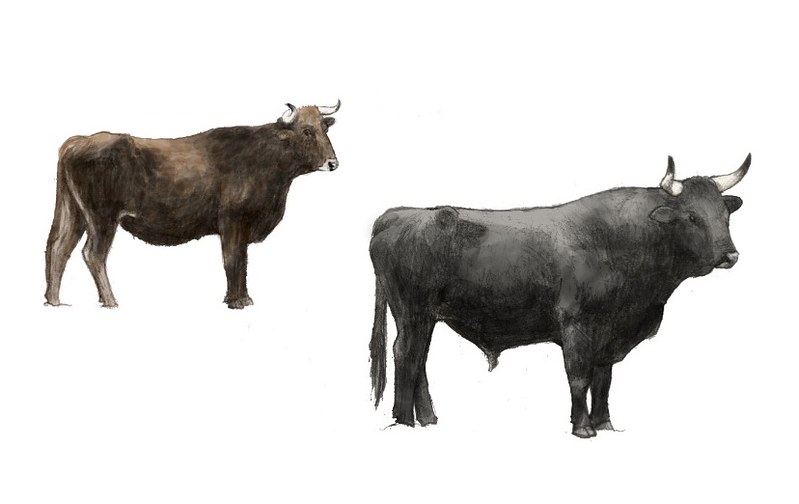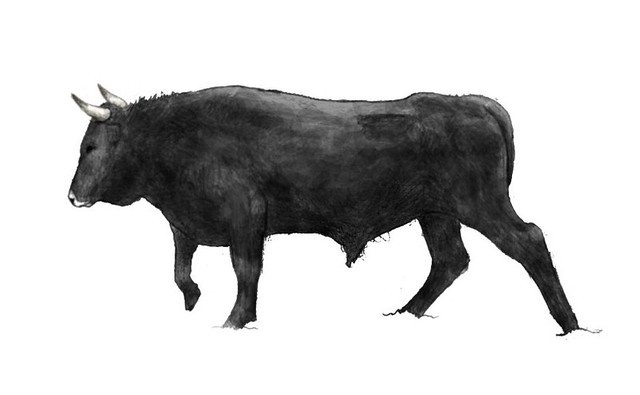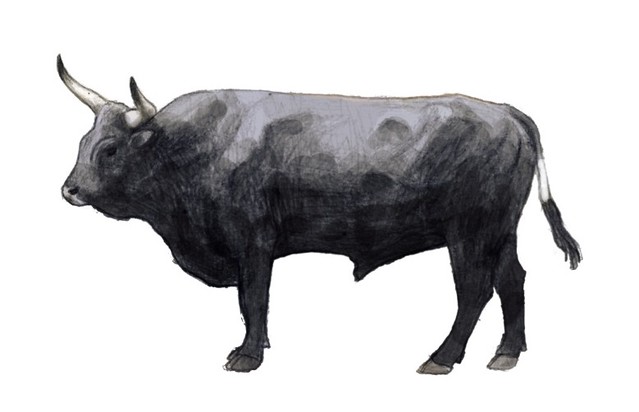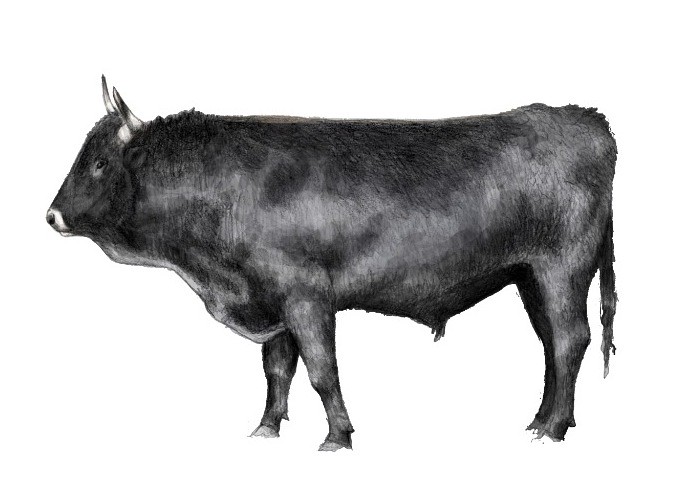Since Heck
cattle has a more than 80 years long history, it might be interesting to take a
little look at the beginnings of this breed. I would like to do this with other
aurochs-like breeds as well, but there is barely any information on that in the
web and not nearly enough to write posts about it.
The only
photo of a early cross of the Heck brothers online is a very small one and I
unfortunately never found it again. But in Walter Frisch’s book (see down
below) there are some useful photos of early Heck cattle from the Berlin as
much as the Munich lineage, which were bred in different zoos respectively. I
scanned them, but I won’t reproduce them here because of copyright issues. But
I tracked them out and created drawings that give an impression of how these
animals looked like, and I took the freedom to paint them to make them more
lively. This sounds speculative, but it is quite easy to deduce the colour from
some of the photos. For example, there is one bull that is definitely brindled
like Highland cattle, another one is obviously black. And the breed
combinations give a clue as well; one of the Berlin cows looks like a cross
with Lidia or Corsica and some Braunvieh in it, so it might have had an
according colour.
Lutz Heck’s
crosses at Berlin
 |
| These two individuals are seemingly mostly Lidia, photo from 1944. |
You’ll
probably know that the two Heck brothers did separate cross experiments,
because they disagreed on certain external features of the aurochs and which
breeds are best-suited for “rebreeding” it. And in fact Lutz’s selection of breeds
was way better than that of his brother. Lidia, Camargue and Corsicana played
an important role in his project, 80% of his first 90 calves were crosses of
those breeds [1]. Good breeds, but not suitable for a complete optical
reconstruction of the aurochs. Later he included Scottish Highland, Algäuer,
Angeln cattle, English Park, Braunvieh, Swedish Fjäll and Steppe cattle [1]. It
seems that he was not satisfied with the offspring of Fjäll and Park cattle [2],
probably because of their side-spotted colour. Some of the Lidia and Corsicana
he obtained had small white spots on their bellies too [2]. Lutz started
breeding in 1927, a little later than his brother. Some of his first-generation
crosses until 1933 were of combinations such as Lidia x Camargue, Camargue x
Corsican, Lidia x Fjäll, Corsican x Park, Corsican x Braunvieh, Corsican x
Steppe, among some purebred calves [1].
 |
| A bull and a cow from the Berlin lineage from 1939. The photo showed only silhouettes on a snowy background. I think these two animals obviously are largely influenced by Corsican. |
 |
| Berlin bull, 1940. No idea which breed combination it is, but perhaps largely Corsican, Camargue and Lidia. |
 |
| Berlin cow from 1944. As I wrote above, I believe this cow is a mix of largely Corsican, perhaps Lidia as well, and a bit of Braunvieh because of the large udder. |
 |
| This is seemingly the only photo of a bull of Lutz Heck's crosses that is online. I think this one is mainly a mix of Lidia and Camargue. |
Unfortunately
no Berlin Heck cattle survived the Second World War. It is not that these cross
combinations were that impressing (and in fact the presence of the Central and
Northern European breeds was counteractive), but the fact that the mere
presence of Lidia and Camargue in the gene pool would have increased the
potential in contemporary Heck cattle a lot because of their very athletic body
and their agile and swift behaviour (and horns facing forwards in the case of
Lidia).
A quite
popular claim of the Heck brothers is that the results of their experiments
allegedly looked virtually identical, thus proving their approach to be successful
[1,2]. The photographs of their cattle do not prove that at all. The cattle at
Berlin had, not surprisingly, a more aurochs-like body, the horns seemed to be
smaller and faced way more forwards. Apart from that, they probably were
smaller as well (Corsicana, Lidia and Camargue are small breeds), and a number
of them were black-coloured instead of wild-coloured. And if there was any
similarity between those two lineages, it would be because a) both Heinz’s as much
as Lutz’s crosses were basically cattle with various colours, body and horn
shapes, so there inevitably was a certain overlap, and b) they did not use a
completely different set of breeds, but actually there was quite an overlap as
well. Corsicana played an important role in both experiments, and Steppe cattle, Highland, Angeln and Braunvieh
were used by Heinz as much as Lutz Heck.
To be
honest, I really regret that the Berlin lineage diminished instead of the
Munich one. Not only because their set of breed would have been a way better
base for the modern Heck population*. The real tragedy behind their extinction
is that they were released into wild areas in the 1940s before their disappearance
because of the war situation. The Rominter Heide (former East Prussia), Bialowieza,
and the Schorfheide in Berlin were populated with a herd of Heck cattle, in the
case of the former two counting about 20 individuals [1]. At Rominten, the
cattle were fed supplementary just as deer, but in Bialowieza they did not have
any supplementary feeding. Because the legal situation was nowhere as strict as
it is today, releasing them into the wild was apparently no problem. Just
imagine these populations survived till today! No matter that their appearance
was not that aurochs-like, they would have adapted perfectly to their
environment during the last 70 years. They would also have had to cope with
predators such as wolves and lynxes. We can assume that they would be fully
dedomesticated in regards to behaviour and ecology today, and very likely
certain aurochs-like features would have been fixed as well. Therefore, the
loss of the released Berlin Heck cattle is very sad in my opinion. Not because
they were cattle bred by one of the Heck brothers, but because of the reasons I
just outlined.
*Why I care about how Heck cattle looks like and how it should look like
will be covered in a future post.
Early
Munich Heck cattle
The cattle
bred by Heinz Heck at Munich are the base of all living Heck cattle. All the
cross animals you see below are ancestors of any living member of the breed, at
least the very early ones. Heck started breeding in 1921, for the founding
breeds see here.
I am going
to go over the animals by chronology.
 |
| The bull "Nordland", half-Steppe cattle yet very Highland-like. UPDATE: It's at least as likely that it is the Highland x Steppe cattle bull Heinz Heck purchased. |
 |
| "Primus" as a young bull, mix of a Corsican cow with the bull above. Its colour probably resembled that of the Maremmana x Limia cross bulls of the Tauros Project. |
 |
| "Glachl", considered the first Heck bull by Heinz Heck, is a mix of Primus with his mother. He was born in 1932, the photo is from 1933 and therefore shows him as a one-year-old. |
 |
| A young bull and a heifer at the Neandertal Zoo, 1951. They have peculiar horn shapes. The bull has horn tips curling backwards, which is not found in any modern Heck bulls that I know. |
 |
| Two Heck bulls at the Munich Zoo 1951. Both of them look identical to some contemporary Heck bulls. |
 |
| This Heck bull at the Munich Zoo, born in 1967, is pretty identical to modern bulls from this zoo. Part of his tail is white. |
 |
| The photo of this bull was taken in 1977. I don't know modern bulls that look exactly like this one, but I would not say it is atypical either. |
“Nordland” was a cross of a Steppe cattle cow and a cross bull of
the combination (Steppe x Highland) x (Angeln x Black-pied). I don’t know if
there are photos of earlier Heck crosses. It had, as you see, a quite longish
and heavy body and very highland-like outwards facing horns. Its coat was very
likely brindled. According to Heck this bull had a considerable influence on
the later crosses. Nordland was mated with a Corsican cow, the first result
being “Primus”. Primus had a
wild-type colour but with a greyish tint according to Heck, unfortunately there
is no available photo of him in later years (the one photo I came across on
google might show Primus in adult state, but I never found it again). Primus
was mated to his mother again, resulting in “Glachl”, born
in 1932 and considered to be the first Heck bull. He and his fullblood sister
showed a correct aurochs coat colour, thanks to being largely Corsican. Unfortunately
I don’t know photos of these two in adult state as well, but I assume that they
looked largely like Corsicana but perhaps heavier.
After this,
Heck unfortunately stopped keeping track of his crosses for whatever reason,
making it impossible to retrace which breed contributed to modern Hecks and to
which extent (you can only try to deduce that by looking at phenotypes, like I
did in my post linked above). However, I consider it likely that the three
bulls and Glachl’s sister were bred to most of the other cattle Heck used, and
that the older but still living individuals were still in use – later on, he
included Braunvieh, Highland once again and English Park to “add mass” (it is
possible that he did not keep the English Park crosses). The Hecks
stopped doing crossbreeding after the end of WWII and spread the remaining ~40
cattle (possibly all of Munich descent) around numerous German zoos.
Occasionally further crossings took place, f.e. with Steppe cattle and one
Watussi cow, but not to a significant extent before the start of the Taurus
cattle project in 1996.
Interestingly
but not surprisingly, many modern Heck cattle look identical or at least very
similar to those, showing that only very loose selection was carried out in Heck
cattle as a whole.
This was
yet another “history lesson” that is not really relevant for contemporary
aurochs “rebreeding”, but I find it quite interesting and I hope some of you
too. What a pity that there are no photos of very old Sayaguesa, Maronesa,
Pajuna, Lidia or any other southern primitive cattle.
Literature
[1] van Vuure, Cis: Retracing the Aurochs - History, Morphology
and Ecology of an extinct wild Ox.
[2] Frisch,
Walter: Der Auerochs – das europäische Rind. 2010.


I love this blog. Keep up the good work! Here's something else I read today that I think you would find interesting.
ReplyDeletehttp://forwhattheywereweare.blogspot.com/2014/04/genetic-paleohistory-of-domestic-cows.html
Wondering what your thoughts on it are, and also if you have any plans to write more posts related to aurochs DNA.
Thanks!
DeleteI know the paper already, it confirms what I thought. Apparently african taurine cattle are of Near eastern origins and Iberian cattle are influenced from african cattle. This is logical from the historic viewpoint and shows that this "use local breeds for local regions for genetic reasons" regionalism is likely baseless.
Yep, I'll definitely write something on the genetic information we have for the aurochs, but it will take some time. At the moment I am preparing a series on dedomestication.
I don´t see what is wrong about saving local landraces, they can indeed constitut important genetic reservoirs and they are locally well adapted.
DeleteAnd in Iberia and in Italy, there are indeed local breeds with rare and unique haplotypes. Not all their cattle are influenced by african cattle at all, actually only a minority (and we could call middle eastern to nearly all the cattle, including the so-called african, which usually has Asian origin after all).
Dear Pachyornis,
ReplyDeleteI know that it does not relate to the current post, but I hope you will check this. Look at that very special bull in the Hortobágy NP! What do you think of this type of horn? Aren’t there rather straighter horns among the fossils similar to this? What do you think?
Best wishes,
A zealous reader :)
https://www.facebook.com/photo.php?fbid=698904286840157&set=pcb.770503969641509&type=1&theater
Hi, thanks for your interest and that link! The bull is very aesthetic, but there are no aurochs skulls that have such horns that I know of, they actually curve more inwards a bit like a shallow spiral.
DeleteOf course that I was speaking about the taurine cattle that we see in North Africa and what I mean with Asia in the end, is Middle Eastern.
ReplyDeleteHey, do you still have the original photographs of these early Heck cattle? I am interested in seeing true photographs of Lutz Heck’s Berlin lineage of Heck cattle and the combination of Camargue, Lidia and Corsicana would seem to bring an animal with a very elegant and athletic body.
ReplyDeleteThe photographs can be seen in Walter Frisch's "Der Auerochs - das europäische Rind" (2010), a very recommendable and beautiful book. You can order it on the homepage www.derauerochs.de
Delete